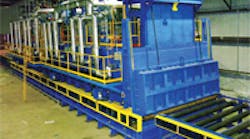Whatever else may be going on in the global economy, heat treating for metalcastings is a hot zone of activity, as manufacturers and processors recognize the value-adding potential — and frequently the necessity — of heat treating. From large-scale system designs to components and controls, heat treating is benefit
Consolidated Engineering Co., a furnace builder and system designer that makes metalcasting one area of specialty, was contracted recently by an unnamed foundry in Mexico to supply a basketless heat-treating system for diesel cylinder heads. CEC said the company intends to produce about 730,000 diesel cylinder heads in a new line of production.
It’s a representative development. Highvolume operations, such as those serving automotive customers, add value to their products as a way to increase revenue incrementally. They’re also responding to rising quality standards from manufacturers with global organizations.
It isn’t just automotive, however. CEC is supplying drop-bottom furnace to an aerospace manufacturer at a plant in Iowa, which will treat critical cast-metal aerospace components with precision control capability. The furnace’s standards for heating up, thermal uniformity, and quenching are cited as the reason for converting the process from a pit furnace operation.
CEC says that the Mexican foundry installation will be the first heat-treating system there capable of air-quenching diesel heads using individual nozzles for each head. The application will result in minimal “partto- part variation,” according to the builder.
Also, it will be that foundry’s first heattreating system without baskets. CEC’s CleanCast systems combine accelerated heat treatment, decoring, and heat retention by moving castings rapidly from the unmolding station to the furnace, in an automated heat-treating cell.
CleanCast is a recent introduction that eliminates the use the familar baskets or trays for holding castings during processing. Individual castings are loaded and unloaded for heat treatment using a conveyor, which it claims will allow the process to achieve better part-to-part uniformity and direct energy savings because “there is less material in the furnace to heat to optimal temperature.” On average, CEC says, the CleanCast system delivers annual savings of 12% of electrical energy and approximately 45% of gas/heating energy.
CEC indicates that the Mexican foundry’s choice of this system over a standard roller-hearth furnace with baskets, and over other basketless systems, reflects CleanCast’s lower operating costs; flexibility to adapt to engine blocks (if needed); modularity, also for future expansions; the ability to remove sand from the castings; and the ability to perform temperature uniformity surveys during production.
Roller-hearth designs continue to be a standard approach to heat treatment, because the idea behind a continuous process is key to one prerogative in heat treating — high-volume processes. For example, Seco/Warwick Corp. designs roller-hearth furnaces in a range of sizes with different heating systems (fuelfired or electric) and cooling techniques, addressing the fact that manufacturers have different reasons for, and obstacles to, achieving higher heat-treating throughput.
In addition to throughput CEC’s designs emphasize energy savings, which it identifies as a key determinant for foundries considering expansions or new equipment purchases. In a statement, the company confirms that operating costs, as well as environmental considerations, are receiving greater emphasis in new designs. “Our engineers,” CEC says, “are now integrating new strategies for energy efficiency in both new equipment and the retrofitting of existing equipment.”
One established way to save energy is through high-efficiency and/or recuperative burners, which are designed to optimize combustion gases and to capture waste gases in order to save fuel and minimize harmful emissions. CEC reports it has installed several thermal-process systems in recent years that route waste gases to boiler systems. The boilers convert the fuel to heat process fluids, or water, or in large applications to drive Rankine-type turbines that generate electrical energy.
In new installations or even in retrofits, direct- or indirect-fired regenerative burners can be applied for combustion applications. Such burners are available in various styles and from different sources, and often are promoted with expectations of quick returns on investment and significant fuel savings. CEC quotes several indirectfiring burners it has designed and installed in Europe, with three-year paybacks and fuel reductions of 23%. “Currently, we are installing direct-fired regenerative burners that have a less than two-year payback,” a CEC source reports, “saving a large forging producer $550,000/year.”
Bringing the technology back to the matter of environmental compliance, CEC says it has install a number of regenerative thermal oxidizers to achieve volatile-organic compound (VOC) reduction. These devices use countercurrent flows across ceramic media and are offered with ROI of two to three years, compared to non-energy reducing units. Other recuperative burners are chosen for their high-temperature or highpressure capabilities.
What’s clear is that the variety of process and capabilities of heat-treating technology are being brought forward by positive manufacturing demands for production efficiency and process quality, but also are making the case on the important concerns for cleanliness and cost-consciousness.










